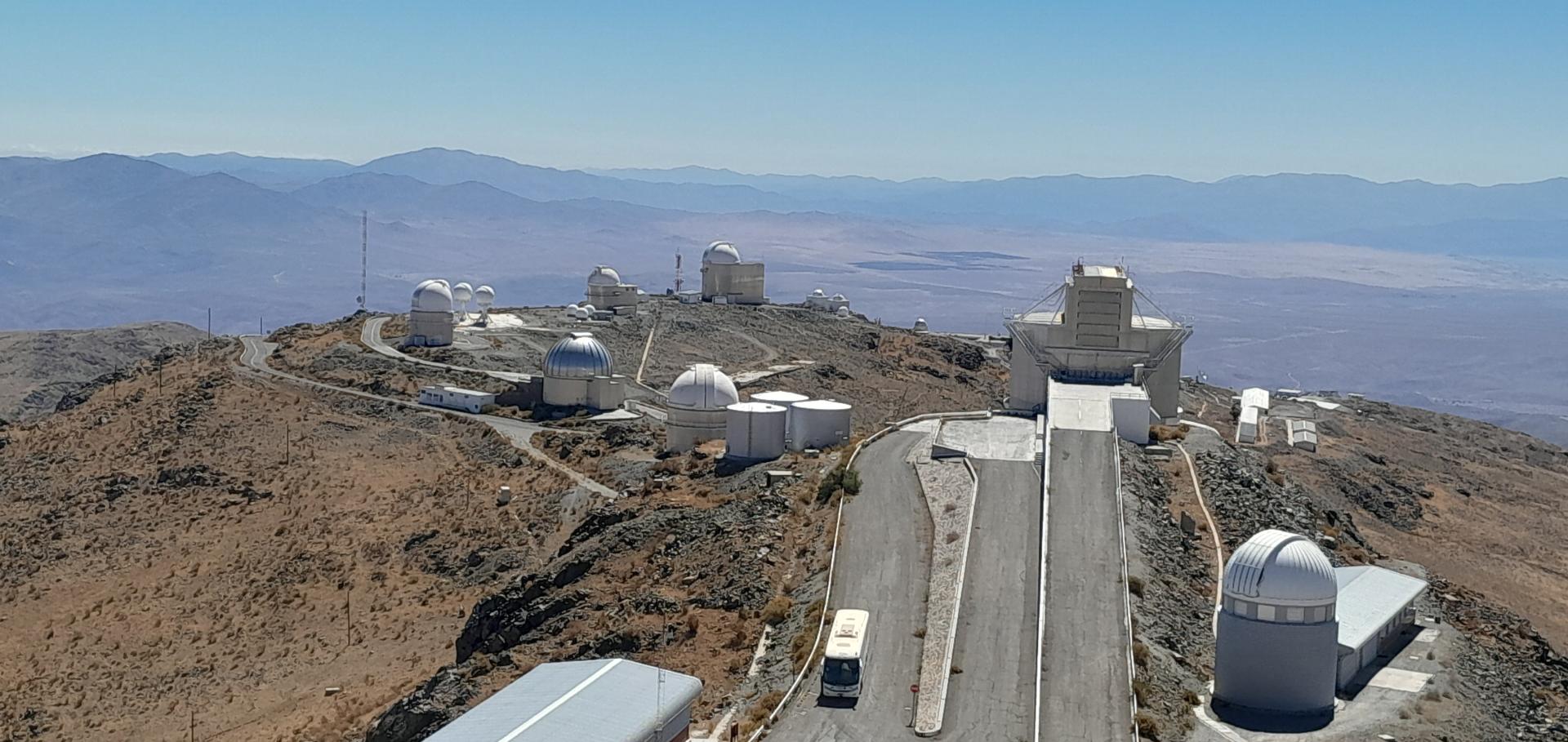Spin-orbit alignment and magnetic activity in the young planetary system AU Mic
Astronomy & Astrophysics, Volume 641, id.L1, 11 pp.
Abstract:
We present high-resolution near-infrared spectropolarimetric observations using the SPIRou instrument at Canada-France-Hawaii Telescope (CFHT) during a transit of the recently detected young planet AU Mic b, with supporting spectroscopic data from iSHELL at NASA InfraRed Telescope Facility. We detect Zeeman signatures in the Stokes V profiles and measure a mean longitudinal magnetic field of ¯Bℓ = 46.3 ± 0.7 G. Rotationally modulated magnetic spots likely cause long-term variations of the field with a slope of dBℓ/dt = -108.7 ± 7.7 G d-1. We apply the cross-correlation technique to measure line profiles and obtain radial velocities through CCF template matching. We find an empirical linear relationship between radial velocity and Bℓ, which allows us to estimate the radial-velocity induced by stellar activity through rotational modulation of spots for the five hours of continuous monitoring of AU Mic with SPIRou. We model the corrected radial velocities for the classical Rossiter-McLaughlin effect, using MCMC to sample the posterior distribution of the model parameters. This analysis shows that the orbit of AU Mic b is prograde and aligned with the stellar rotation axis with a sky-projected spin-orbit obliquity of λ = 0°-15°+18°. The aligned orbit of AU Mic b indicates that it formed in the protoplanetary disk that evolved into the current debris disk around AU Mic.
Based on observations obtained at the Canada-France-Hawaii Telescope (CFHT) which is operated from the summit of Maunakea by the National Research Council of Canada, the Institut National des Sciences de l'Univers of the Centre National de la Recherche Scientifique of France, and the University of Hawaii. Based on observations obtained with SPIRou, an international project led by Institut de Recherche en Astrophysique et Planétologie, Toulouse, France.
Based on observations obtained at the Canada-France-Hawaii Telescope (CFHT) which is operated from the summit of Maunakea by the National Research Council of Canada, the Institut National des Sciences de l'Univers of the Centre National de la Recherche Scientifique of France, and the University of Hawaii. Based on observations obtained with SPIRou, an international project led by Institut de Recherche en Astrophysique et Planétologie, Toulouse, France.
The distribution of dark matter and gas spanning 6 Mpc around the post-merger galaxy cluster MS 0451-03
Monthly Notices of the Royal Astronomical Society, Volume 496, Issue 3, pp.4032-4050
Abstract:
Using the largest mosaic of Hubble Space Telescope images around a galaxy cluster, we map the distribution of dark matter throughout an ∼6 × 6 Mpc2 area centred on the cluster MS 0451-03 (z = 0.54, M200=1.65×1015M⊙ ). Our joint strong- and weak-lensing analysis shows three possible filaments extending from the cluster, encompassing six group-scale substructures. The dark matter distribution in the cluster core is elongated, consists of two distinct components, and is characterized by a concentration parameter of c200 = 3.79 ± 0.36. By contrast, XMM-Newton observations show the gas distribution to be more spherical, with excess entropy near the core, and a lower concentration of c200=2.35+0.89−0.70 (assuming hydrostatic equilibrium). Such a configuration is predicted in simulations of major mergers 2-7 Gyr after the first core passage, when the two dark matter haloes approach second turnaround, and before their gas has relaxed. This post-merger scenario finds further support in optical spectroscopy of the cluster's member galaxies, which shows that star formation was abruptly quenched 5 Gyr ago. MS 0451-03 will be an ideal target for future studies of the growth of structure along filaments, star formation processes after a major merger, and the late-stage evolution of cluster collisions.
Simulating radial velocity observations of trappist-1 with SPIRou
Monthly notices of the Royal Astronomical Society 488 5144
Abstract:
We simulate a radial velocity (RV) follow-up of the TRAPPIST-1 system, a faithful representative of M dwarfs hosting transiting Earth-sized exoplanets to be observed with SPIRou in the months to come. We generate an RV curve containing the signature of the seven transiting TRAPPIST-1 planets and a realistic stellar activity curve statistically compatible with the light curve obtained with the K2 mission. We find a ±5 m s-1 stellar activity signal comparable in amplitude with the planet signal. Using various sampling schemes and white noise levels, we create time-series from which we estimate the masses of the seven planets. We find that the precision on the mass estimates is dominated by (i) the white noise level for planets c, f, and e and (ii) the stellar activity signal for planets b, d, and h. In particular, the activity signal completely outshines the RV signatures of planets d and h that remain undetected regardless of the RV curve sampling and level of white noise in the data set. We find that an RV follow-up of TRAPPIST-1 using SPIRou alone would likely result in an insufficient coverage of the rapidly evolving activity signal of the star, especially with bright-time observations only, making statistical methods such as Gaussian Process Regression hardly capable of firmly detecting planet f and accurately recovering the mass of planet g. In contrast, we show that using bi-site observations with good longitudinal complementary would allow for a more accurate filtering of the stellar activity RV signal.
A possible misaligned orbit for the young planet AU Mic c
Monthly Notices of the Royal Astronomical Society, Volume 536, Issue 3, pp.2046-2063
Abstract:
The AU Microscopii planetary system is only 24 Myr old, and its geometry may provide clues about the early dynamical history of planetary systems. Here, we present the first measurement of the Rossiter-McLaughlin effect for the warm sub-Neptune AU Mic c, using two transits observed simultaneously with the European Southern Observatory's (ESO's) Very Large Telescope (VLT)/Echelle SPectrograph for Rocky Exoplanets and Stable Spectroscopic Observations (ESPRESSO), CHaracterising ExOPlanet Satellite (CHEOPS), and Next-Generation Transit Survey (NGTS). After correcting for flares and for the magnetic activity of the host star, and accounting for transit-timing variations, we find the sky-projected spin-orbit angle of planet c to be in the range λc=67.8+31.7−49.0 degrees (1σ). We examine the possibility that planet c is misaligned with respect to the orbit of the inner planet b (λb=−2.96+10.44−10.30), and the equatorial plane of the host star, and discuss scenarios that could explain both this and the planet's high density, including secular interactions with other bodies in the system or a giant impact. We note that a significantly misaligned orbit for planet c is in some degree of tension with the dynamical stability of the system, and with the fact that we see both planets in transit, though these arguments alone do not preclude such an orbit. Further observations would be highly desirable to constrain the spin-orbit angle of planet c more precisely.
Full Stokes magnetometry of the active M dwarfs AU Mic and EV Lac with SPIRou
Astronomy & Astrophysics, Volume 700, id.A122, 14 pp.
Abstract:
We report in this paper circularly and linearly polarized observations of the young active M dwarfs AU Mic and EV Lac with the near-infrared SPIRou spectropolarimeter at the Canada–France–Hawaii Telescope, collected from August to October 2023 over a few rotation cycles of both stars. Applying Least-Squares Deconvolution (LSD) to our spectra, we detected Zeeman signatures in circular (Stokes V) and linear (Stokes QU) polarization, and Zeeman broadening in unpolarized (Stokes I) LSD profiles, all exhibiting clear rotational modulation. Using the stellar surface tomographic technique of Zeeman-Doppler imaging on our sets of observations, along with a simple parametric description of how the small-scale and large-scale fields relate to each other, we recovered the magnetic topologies of AU Mic and EV Lac successively from LSD Stokes V, Stokes IV and Stokes IVQU profiles, to investigate how the reconstructed maps evolve as we provide more information, and ultimately infer reliable magnetic maps of both stars. We find that AU Mic hosts a fairly simple and mostly poloidal large-scale field aligned with the rotation axis within about 10°, whereas that of EV Lac is more complex, stronger and less axisymmetric. Both stars feature intense small-scale fields, of about 4 kG for AU Mic and 6 kG for EV Lac when averaged over the whole stellar surface. Stokes QU Zeeman signatures allow one to reconstruct stellar magnetic fields more reliably, and are especially useful for stars with more complex fields and low υ sin i like EV Lac.


